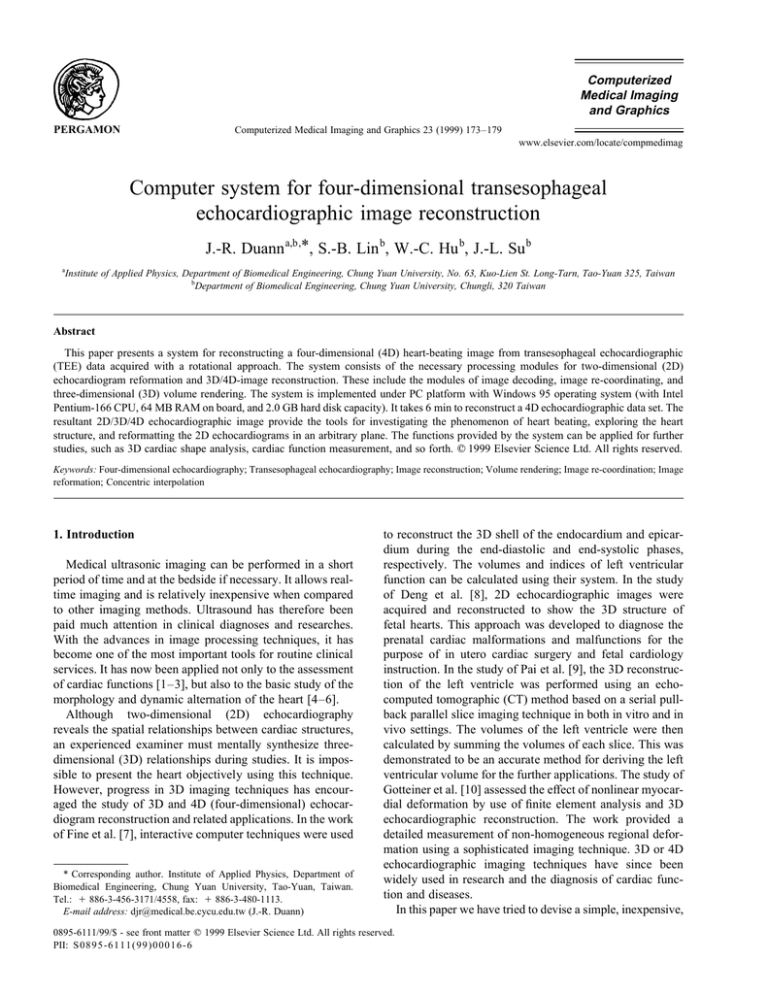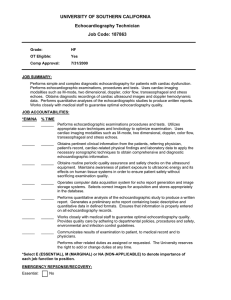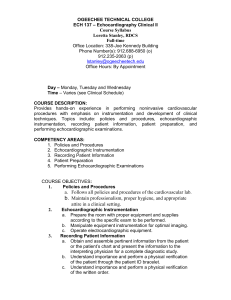
Computerized
Medical Imaging
and Graphics
PERGAMON
Computerized Medical Imaging and Graphics 23 (1999) 173–179
www.elsevier.com/locate/compmedimag
Computer system for four-dimensional transesophageal
echocardiographic image reconstruction
J.-R. Duann a,b,*, S.-B. Lin b, W.-C. Hu b, J.-L. Su b
a
Institute of Applied Physics, Department of Biomedical Engineering, Chung Yuan University, No. 63, Kuo-Lien St. Long-Tarn, Tao-Yuan 325, Taiwan
b
Department of Biomedical Engineering, Chung Yuan University, Chungli, 320 Taiwan
Abstract
This paper presents a system for reconstructing a four-dimensional (4D) heart-beating image from transesophageal echocardiographic
(TEE) data acquired with a rotational approach. The system consists of the necessary processing modules for two-dimensional (2D)
echocardiogram reformation and 3D/4D-image reconstruction. These include the modules of image decoding, image re-coordinating, and
three-dimensional (3D) volume rendering. The system is implemented under PC platform with Windows 95 operating system (with Intel
Pentium-166 CPU, 64 MB RAM on board, and 2.0 GB hard disk capacity). It takes 6 min to reconstruct a 4D echocardiographic data set. The
resultant 2D/3D/4D echocardiographic image provide the tools for investigating the phenomenon of heart beating, exploring the heart
structure, and reformatting the 2D echocardiograms in an arbitrary plane. The functions provided by the system can be applied for further
studies, such as 3D cardiac shape analysis, cardiac function measurement, and so forth. q 1999 Elsevier Science Ltd. All rights reserved.
Keywords: Four-dimensional echocardiography; Transesophageal echocardiography; Image reconstruction; Volume rendering; Image re-coordination; Image
reformation; Concentric interpolation
1. Introduction
Medical ultrasonic imaging can be performed in a short
period of time and at the bedside if necessary. It allows realtime imaging and is relatively inexpensive when compared
to other imaging methods. Ultrasound has therefore been
paid much attention in clinical diagnoses and researches.
With the advances in image processing techniques, it has
become one of the most important tools for routine clinical
services. It has now been applied not only to the assessment
of cardiac functions [1–3], but also to the basic study of the
morphology and dynamic alternation of the heart [4–6].
Although two-dimensional (2D) echocardiography
reveals the spatial relationships between cardiac structures,
an experienced examiner must mentally synthesize threedimensional (3D) relationships during studies. It is impossible to present the heart objectively using this technique.
However, progress in 3D imaging techniques has encouraged the study of 3D and 4D (four-dimensional) echocardiogram reconstruction and related applications. In the work
of Fine et al. [7], interactive computer techniques were used
* Corresponding author. Institute of Applied Physics, Department of
Biomedical Engineering, Chung Yuan University, Tao-Yuan, Taiwan.
Tel.: 1 886-3-456-3171/4558, fax: 1 886-3-480-1113.
E-mail address: djr@medical.be.cycu.edu.tw (J.-R. Duann)
to reconstruct the 3D shell of the endocardium and epicardium during the end-diastolic and end-systolic phases,
respectively. The volumes and indices of left ventricular
function can be calculated using their system. In the study
of Deng et al. [8], 2D echocardiographic images were
acquired and reconstructed to show the 3D structure of
fetal hearts. This approach was developed to diagnose the
prenatal cardiac malformations and malfunctions for the
purpose of in utero cardiac surgery and fetal cardiology
instruction. In the study of Pai et al. [9], the 3D reconstruction of the left ventricle was performed using an echocomputed tomographic (CT) method based on a serial pullback parallel slice imaging technique in both in vitro and in
vivo settings. The volumes of the left ventricle were then
calculated by summing the volumes of each slice. This was
demonstrated to be an accurate method for deriving the left
ventricular volume for the further applications. The study of
Gotteiner et al. [10] assessed the effect of nonlinear myocardial deformation by use of finite element analysis and 3D
echocardiographic reconstruction. The work provided a
detailed measurement of non-homogeneous regional deformation using a sophisticated imaging technique. 3D or 4D
echocardiographic imaging techniques have since been
widely used in research and the diagnosis of cardiac function and diseases.
In this paper we have tried to devise a simple, inexpensive,
0895-6111/99/$ - see front matter q 1999 Elsevier Science Ltd. All rights reserved.
PII: S0895-611 1(99)00016-6
174
J.-R. Duann et al. / Computerized Medical Imaging and Graphics 23 (1999) 173–179
Fig. 1. Sketches of the transformation from the rotating set of slice into a Zseries of slices. (a) Schematic diagram of a set of slices acquired in the
rotational approach respects to the Z-axis. (b) Schematic diagram of a set of
Z-slices.
As the image data set is acquired with rotational approach
and is natively the conical form, it is necessary to convert
the acquired 3D image data set from conical form to cubic
for the further processing. That is, a transformation is
required to convert the image data set from the polar
coordinate system
r; u; z to the Cartesian one
x; y; z:
This re-coordinates a set of slices rotated along a common
axis to a set of z-slices. The relationship between the transformed 3D cubic volume data set and the rotational image
data set is given by:
G
x; y; z g
r; u; z;
x r cos
u;
and clinically useful system which provides the functions to
reconstruct 3D and 4D echocardiograms from time-evolving 3D transesophageal echocardiographic (TEE) images
on a PC platform. Our system has been sought to: (a) recoordinate the TEE images from the rotational data set to
the cubic one; (b) reconstruct static or dynamic 3D/4D echocardiography; and (c) reformat 2D echocardiograms from
an arbitrary angle using the re-coordinated cubic data set. In
addition, we integrated the necessary processing modules,
such as image decoding, image re-coordinating, image
reformatting, 3D image reconstruction and image display
modules, into an integrated software program with a userfriendly operating interface. The following sections will
describe the processing modules in detail, with several
experimental results given at the end to illustrate the functions of the developed system.
2. Image re-coordination
The subject to be discussed in this paper is 3D transesophageal echocardiography, which is performed using a
multiplane transesophageal probe and a commercially available ultrasound system (HP Sonos 2500, Hewlett-Packard,
Andover, USA) in the 3D/4D protocol. In this imaging
method a rotational technique of data acquisition has been
used to obtain a 3D time-evolving echocardiographic image
data set [11,12]. The transducer is held stable at one point,
and the transducer probe itself or the transducer element
within the probe is rotated around a pivot point, which is
always located at the tip of the imaging probe. Generally,
this pivot point is fixed and the relative motion between the
transducer and heart is negligible, it can be the reference
point to stack and reconstruct the time-evolving 3D image
set. A computer-controlled motor advances the sectors 2–
108 over a span of 1808 and generates a conical 3D data set.
At each imaging position, the ECG-gated imaging technique
is used to enable the image acquisition from the R-wave
detected. Many time frames, commonly 21 frames, can be
acquired during a cardiac cycle. The frame rate is dependent
upon the length of cardiac cycle of the patient. Then the
transducer is rotated to the next imaging position and waiting for the next triggering signal.
1
y r sin
u
z z;
where G is the gray level of the voxel at position
x; y; z in
the z-series of slices, and g represents the gray level of the
voxel at position
r; u; z in the rotating slices. r is the
distance from the position of transducer to the projected
point of the voxel onto the x–y plane. u is determined by
the slice number that corresponds to the degree of rotation
of the transducer. In this approach, we calculate the r- and
u -components of the voxel in polar coordinates, which
correspond to the x- and y-components of the same voxel
in Cartesian coordinate; and find the gray level of the voxel
at position
r; u; z in the original image data set (in polar
coordinate). The transformation of a rotating set of slices to
a Z-series of slices is shown in Fig. 1 [13].
In addition, the converted cubic volume undergoes interpolation to fill in the gray level of the extra voxels that are
generated during the re-coordination process and lose on the
other hand a specified gray level. As the rotational approach
is used to acquire echocardiographic images, some voxels
lose a gray level when the original image data set is
converted to the cubic volumetric data set. For the example
of a volume data set with size 240 × 240 × 108; the gap in
the outermost circle between two adjoining rotational slices
acquired every 28 is more than four voxels
120 × sin 28: It
is necessary to calculate the gray level of these extra voxels
by interpolation processes. For that purpose, concentric
interpolation is used to perform the necessary interpolation.
The gray level of the extra voxel is calculated by linear
interpolation using the neighborhood voxels with the same
concentric distance as the extra voxel. For instance, by
calculating the radius and angle of the voxel to be transformed with Eq. (1), we obtain the coordinate of the calculated voxel in the rotating image data set
r; u
corresponding to that in 3D cubic volume data set
x; y: If
the derived angle cannot be found in the conical data set, it
means that there is no gray level attributed to this calculated
voxel. Therefore, the voxels in the original image data set
with the same radius as the calculated voxel but with the
angle after and prior to that of the calculated voxel are
averaged to estimate its gray level. This method is called
“concentric interpolation”.
J.-R. Duann et al. / Computerized Medical Imaging and Graphics 23 (1999) 173–179
175
Fig. 2. The reformation of 2D echocardiogram. On the right panel, the cube shows the recoordinated cubic echocardiographic image data, the frame inside the
cube and with a arrow attached on it is the resampled 2D frame, and the arrow displays the direction to resample the 2D echocardiograms. On the left panel, it
displays the resultant 2D echocardiogram in the short-axis cutting plane.
3. 3D echocardiogram reformation
Image reformation is used to extract a 2D echocardiogram in an arbitrary cut plane from the 3D cubic volume
data set. To achieve this, a user-friendly interface must be
implemented to allow users to select the correct image plane
as easily as possible. In our system, a computer-generated
cubic wire frame containing rectangle is used as a slice
locator (Fig. 2). The cubic wire frame is analogous to the
re-coordinated 3D cubic volume data. The rectangular plane
inside the cubic wire frame is used to represent the position
of the image plane that is extracted from the 3D cubic
volume data.
There is a small arrow called reformation pointer at the
center of the rectangular plane. It is used to indicate the
direction of projection from the 3D cubic volume data to
the scene or viewers. That is, it points out the side of the
image plane that will be displayed. Along the direction
specified by the reformation pointer, a series of slices can
be collected to form another z-series slices (Fig. 2). In order
to define the direction of the reformation pointer, the degree
of rotation of the reformation pointer respective to the x-, y-,
and z-axis can be assigned by using the mouse (left to
decrease and right to increase the angle). The rectangular
plane can also be moved freely in the x-, y-, and z-axis to
determine the position to start reformation. However, in
order to retain the rectangular shape of the reformatted
slices, the coordinates of the four corners are recalculated
according to the position and direction of the reformation
pointer and the size of the reformatted image slice
e:g: 240 × 240:
After the direction and position of the slice locator have
been determined, the coordinates of every pixel inside the
reformatted slice are evaluated. The recreated 2D echocardiogram is generated by checking the gray level of the
voxels in the 3D cubic volume data set. Moreover, the direction of the reformation pointer of the slice locator can also
be referred to as the direction of central projection for 3D/
4D-image reconstruction.
4. 3D/4D echocardiographic image reconstruction
In our approach, several procedures are integrated to
reconstruct 3D/4D echocardiographic images. These consist
of selection of viewing angle, image smoothing by masking,
selecting a color palette from a look-up table, volume
rendering and hidden surface removal by the use of a
z-buffer algorithm, as well as shading. In the process of
viewing angle selection, the slice locator is used to
define the direction of projection from object to scene
or viewer. After the direction of viewing angle has been
determined, the 3D cubic volume data is smoothed by
either a 3 × 3 × 3 or 5 × 5 × 5 averaging mask, depending
on the image quality of the original echocardiography,
to obtain a volumetric image data set with a more
176
J.-R. Duann et al. / Computerized Medical Imaging and Graphics 23 (1999) 173–179
5. Experimental results
Fig. 3. The software structure of the developed 4D echocardiographic
reconstruction system. It consists of: one image decoder (HP TIFF
image); one image encoder (3D cubic volume data); and five image processing modules.
homogeneous distribution of gray level. If the smoothed 3D
cubic volume data are too dark to display, a suitable color
table may be chosen to increase the gray level. Later the 3D
cubic volume data undergo 3D reconstruction with simple
volume rendering and shading. In our system, parallel projection is used to speed up the process of 3D reconstruction. To
eliminate the invisible front faces surviving the back-face
removal algorithm, which are obscured by some object
close to the scene or viewer, the z-buffer or depth-buffer
algorithm is used in our system. It is considered a pixelwise
bubble sort of the z-depth of all polygons pierced by the
projector ray to the pixel. The results of the z-buffering
process are then lightened with a single light source and
shaded by Gouraud shading to complete the 3D reconstruction [14,15].
The system for 4D echocardiographic image reconstruction was implemented according to the description in the
previous sections. Fig. 3 shows the software structure of the
system. The system consists of five necessary components
for 4D echocardiographic image reconstruction. These were
the HP TIFF image decoder, image re-coordination, slice
locator, volume rendering, and image representation
modules.
As the raw data acquired by the HP Sonos 2500 ultrasound imager were encoded in the TIFF image file format, it
was necessary to decompress the raw data to obtain the
whole data set in four dimensions. After the raw image
data files had been decoded, the image re-coordination
process was performed to convert the original image data
set in rotational format into that in 3D cubic format. The
system also provides the option of storing the 3D cubic
volume data in the storage device for further processing.
Using the 3D cubic volume data, the slice locator can be
used to reformat a 2D echocardiogram in an arbitrary cut
plane, and the volume rendering routine can be used to build
a 3D static image. Further, the resultant images obtained by
every process can be displayed by the image presentation
module. These functions are all integrated in a single
program to provide the user with a comprehensive perception of dynamic heart activity and structure by means of
TEE images. The system is extremely suitable not only
for functional research of the heart but also for both static
and dynamic structural studies.
Fig. 4. Multiplane transesophageal echocardiography acquired in the rotational approach. From left to right and top to down, it shows the sequence of
acquisition from 0 to 808 and with 48 for each frame.
J.-R. Duann et al. / Computerized Medical Imaging and Graphics 23 (1999) 173–179
177
As for execution time, to transform the rotating slices to
cubic z-series slices with the system on the PC platform, it
takes about 30 s with the smoothing process on the 3D cubic
volume data and 25 s without. For reconstructing the 3D
echocardiography for all time frames after the slice position
and the threshold have been determined, the system should
take only 6 min. That is, all processes needed to reconstruct
the 4D echocardiography from the TEE image data set
would take less than half an hour to complete.
6. Summary
Fig. 5. Static 3D echocardiography with volume rendering and shading.
The system software was written in Microsoft Visual
C11 version 5.0 programming language and MFC class
library version 4.2 under Windows environment and ran
on a personal computer with an Intel Pentium-166 CPU,
64 MB RAM on board, and 2.0 GB hard disk capacity. As
the TEE images used were acquired in rotational approach
from 0 to 1808 with 28 increments, there were 91 frames for
every time phase. Generally, the R–R interval was divided
into 42 time frames, that is, there were 3822 frames generated in one examination. When considering the size and
resolution of single frames of the echocardiographic images,
the resultant data volume was more than 260 MB
240 ×
240 × 108 × 42; which was too large to store in the hard
disk of the working system. An auxiliary CD-recorder was
therefore connected to store the re-coordinated 3D cubic
volume data and reduce the workload of the system storage
device so that enough storage capacity could be reserved for
other processes.
In Fig. 4 a series of TEE images acquired in the rotational
approach are displayed as an example of 4D echocardiographic image reconstruction. From left to right and top to
bottom, Fig. 4 shows the TEE images from 0 to 808 with a 48
increment for each image frame. These frames were chosen
from the rotational image data set with 91 image frames.
The original image data set underwent image re-coordination and concentric interpolation to generate 3D cubic
volume data. All other functions were derived from the
3D cubic volume data. The reformatted 2D echocardiogram
accompanied by the slice locator is shown in Fig. 2. From the
sketch of slice locator, we can see the position of the reformatted 2D echocardiogram relative to the 3D cubic volume
data. Fig. 5 shows the resultant 3D echocardiography
reconstructed with the processes of volume rendering and
shading. The resultant dynamic 4D echocardiographic images
changing through the cardiac cycle are shown in Fig. 6.
By using transesophageal echocardiography (TEE), a 4D
image data set can be obtained with ECG triggering and a
rotating ultrasound transducer. According to the characteristics of the acquired data set, we developed an integrated
system to perform 4D echocardiographic image reconstruction and display in this paper. This system provides several
functions for 3D echocardiographic image reconstruction,
3D echocardiographic image reconstruction with time
evolution (4D echocardiography), 2D echocardiogram
reformation in any arbitrary cut plane, and other necessary
processes for TEE images. The 2D, 3D and 4D echocardiography can be easily reconstructed within the integrated
system running on inexpensive and commonly available
hardware and software. Moreover, the results show the
feasibility of the 4D echocardiographic image reconstruction system.
In reconstructing 3D or 4D images from 2D data, limitations are encountered at each stage of the process. In the
stage of image acquisition, poor quality echocardiography
affects the results of 4D image reconstruction most. During
3D image reconstruction, a threshold must be determined
for volume rendering. Poor image quality always makes this
determination difficult. In addition, motion of the patient
may also complicate the process of image reconstruction.
As the acquisition of TEE images is performed during
multiple cardiac cycles, the results of echocardiography
often deteriorate due to patient movement. This may
cause the artifact of shifts in some slices within the 3D
cubic volume data, and deform the resultant 3D/4D echocardiography.
Lack of a global positioning system for image acquisition
is another problem of 3D image reconstruction in echocardiography. An in vivo or in vitro landmark is needed for the
image alignment process when the series of images are
acquired at different times. Artifacts caused by patient
movement can also be corrected by using such a landmark.
Therefore, an inexpensive and clinically feasible locator
serving as a landmark would be an important auxiliary facility needed for TEE image acquisition in the future to make
3D/4D echocardiographic image reconstruction more
precise and accurate.
In the stage of 3D reconstruction, the most intensive
computations are performed during image re-coordination.
178
J.-R. Duann et al. / Computerized Medical Imaging and Graphics 23 (1999) 173–179
Fig. 6. Contiguous image frames extracted from the 4D echocardiography reconstructed by the developed system. The activity of the mitral valve can easily be
observed in the dynamic 4D echocardiography.
It is very time-consuming to calculate the sine–cosine pair
for converting a location represented by polar coordinating
system
r; u; z to that represented by the Cartesian coordinating system
x; y; z: In order to reduce the computation time, some accelerating mechanism should be
introduced. Considering the data structure of the TEE
image data set and the transformation in Eq. (1), only
the coordinates of r and u (or x and y) are needed to
convert the coordinate system within the same slice.
That is, the data set is independent in the z-axis.
Thus, the sine and cosine calculations for transforming
the coordinated are estimated in advance and
constructed as a looking-up-table. While the image
re-coordinating process is performed, the complex calculation can be massively reduced. It can efficiently accelerate
the 4D reconstruction as the image re-coordination is the
bottleneck of the whole process. Besides, the interface
between the computing hardware and the ultrasound imager
is also included to transfer the rotating z-slice image data set
directly to the auxiliary computing hardware. The purpose is
to link the ultrasound imager with self-designed computing
hardware and to generate output in the 3D cubic volumetric
format which will make processing easier for further
research work.
Acknowledgements
I wish to thank Dr Tsui-Lieh Hsu, Director of Echo
Room, Department of Cardiology, Veterans General Hospital, Taipei, for having provided plenty of material to validate
our system, and also to the anonymous reviewers, who give
us the most helpful suggestion to revise our manuscripts. I
also greatly appreciate Shan-Hui Hsu, PhD scholar in the
Department of Chemical Engineering of National Chung
Hsin University who revised this manuscript for us.
References
[1] van Royen N, Jaffe CC, Krumholz HM, Johnson KM, Lynch PJ,
Natale D, Atkinson P, Deman P, Wackers FJTh. Comparison and
Reproducibility of visual echocardiographic and quantitative radionuclide left ventricular ejection fractions. Am J Cardiol 1996;77:843–
850.
[2] Belohlavek M, Foster SM, Kinnick RR, Greenleaf JF, Seward JB.
J.-R. Duann et al. / Computerized Medical Imaging and Graphics 23 (1999) 173–179
[3]
[4]
[5]
[6]
[7]
[8]
[9]
[10]
[11]
[12]
[13]
Reference techniques for left ventricular volume measurement by
three-dimensional echocardiography: determination of precision,
accuracy, and feasibility. Echocardiography 1997;14(4):329–335.
Ali S, Egeblad H, Steensgard-Hansen F, Saunamaki K, Carstensen S,
Haunso S. Echocardiographic assessment of regional and global left
ventricular function: wall-motion scoring in parasternal and apical
views
versus
apical
views
alone.
Echocardiography
1997;14(4):313–320.
Bjornstad K, Mahle J, Aakhus S, Torp HG, Hatle LK, Angelsen BAJ.
Evaluation of reference systems for quantitative wall motion analysis
from three-dimensional endocardial surface reconstruction: an echocardiographic study in subjects with and without myocardial infarction. Am Card Imag 1996;10(4):244–253.
Hashimoto Y, Reid CL, Gardin JM. Left ventricular cavitary geometry and dynamic intracavitary left ventricular obstructure during
dobutamine stress echocardiography. Am J Card Imag
1996;10(3):163–169.
Lessick J, Sideman S, Azhari H, Marcus M, Grenadier E, Beyar R.
Regional three-dimensional geometry and function of left ventricles
with fibrous aneurysms: a cine-computed topography study. Circulation 1991;84:1078–1086.
Fine DG, Sapoznikov D, Mosseri M, Gotsman MS. Three-dimensional echocardiographic reconstruction: qualitative and quantitative
evaluation of ventricular function. Comput Meth Prog Biomed
1988;26:33–44.
Deng J, Garderner JE, Rodeck CH, Lees WR. Fetal echocardiography
in three and four dimensions. Ultrasound Med Biol 1996;22(8):979–
986.
Pai RG, Jintapakorn W, Tanimoto M, Cao Q, Pandian N, Shah PM.
Three-dimensional echocardiographic reconstruction of the left
ventricle by a transesophageal tomographic technique: in vitro and
in vivo validation of its volume measurement. Echocardiography
1996;13(6):613–621.
Gotteiner NL, Han G, Chandran KB, Vonesh MJ, Bresticker M,
Greene R, Oba J, Kane BJ, Joob A, McPherson DD. In vivo assessment of nonlinear myocardial deformation using finite element analysis and three-dimensional echocardiographic reconstruction. Am J
Card Imag 1995;9(3):185–194.
Ghosh A, Nanda NC, Maurer G. Three-dimensional reconstruction of
echocardiographic images using the rotation method. Ultrasound
Med. Biol. 1989;6:323–337.
Pini R, Monnini E, Masotti L. Echocardiographic three-dimensional
visualization of the heart. NATO ASI series 1990;60:263–274.
Masters BR, Senft SL. Transformation of a set of slices rotated on a
common axis to a set of z-slices: application to three-dimensional
visualization of the in vivo human lens. Comput Med Imag Graphics
1997;21(3):145–151.
179
[14] Firebaugh MW. Three-dimensional graphics: fundamentals, Computer graphics: tools for visualization. Dubuque, IA: Wm. C. Brown
Communications, 1993, chap. 7, p. 167–96.
[15] Adams L. Getting started with view geometry, Visualization and
virtual reality: 3D programming with visual basic for windows.
New York: McGraw-Hill, 1993, chap. 6, p. 41–57.
Jeng-Ren Duann received his BS and MS degrees in biomedical engineering and PhD degree in Applied Physics from the Chung Yuan
University, Chungli, Taiwan in 1990, 1992 and 1999, respectively.
His current research interests include the construction of dynamic beating-heart model, medical signal and image processing, functional brain
imaging, and medial informatics.
Song-Bin Lin received the BS and MS degrees in biomedical engineering from Chung Yuan University, Chungli, Taiwan in 1998 and 1999.
His research interests are concentrated on the medical image processing
and 3D image reconstruction. He is now working on the development of
automatic edge detection algorithm for echocardiography.
Wei-Chih Hu graduated from Chung Yuan University, Taiwan, in 1977
and received his PhD from the University of North Carolina at Chapel
Hill in 1989. His interest includes research on cardiovascular hemodynamics using pressure volume relation as well as medical images. He is
actively involved in cardiac and vascular imaging research with Veteran
General Hospital, Taipei, Taiwan. He is currently an associate professor
in Department of Biomedical Engineering at Chung Yuan University,
Taiwan.
Jenn-Lung Su received the BS (Honors) degree in biomedical engineering from Chung Yuan University, Chungli, Taiwan in 1977. He
received the MS and PhD degrees in bioengineering in 1985 and
1988, respectively, both from The University of Illinois, Chicago. He
was the Chairman of the Department of Biomedical Engineering,
Chung Yuan University, from 1989 to 1995. Since 1988, he has been
an Associated Professor in Chung Yuan University. He also served as
the Chief Editor of Chinese Journal of Medical and Biological Engineering since 1996 and secretaries in General of the Biomedical Engineering Society of ROC (Chinese, Taipei) since 1999. His current
research interests include medical imaging, medical informatics, and
electromagnetic interaction with biological systems.





